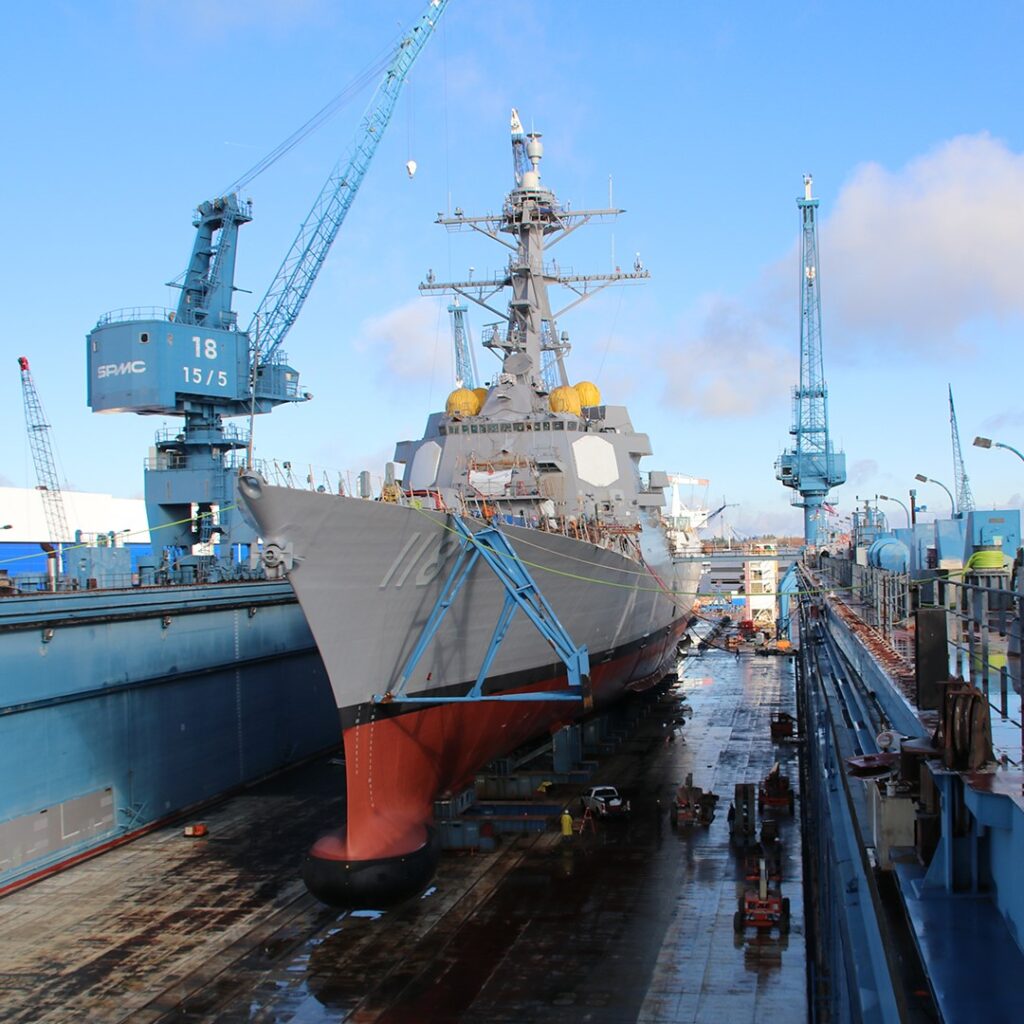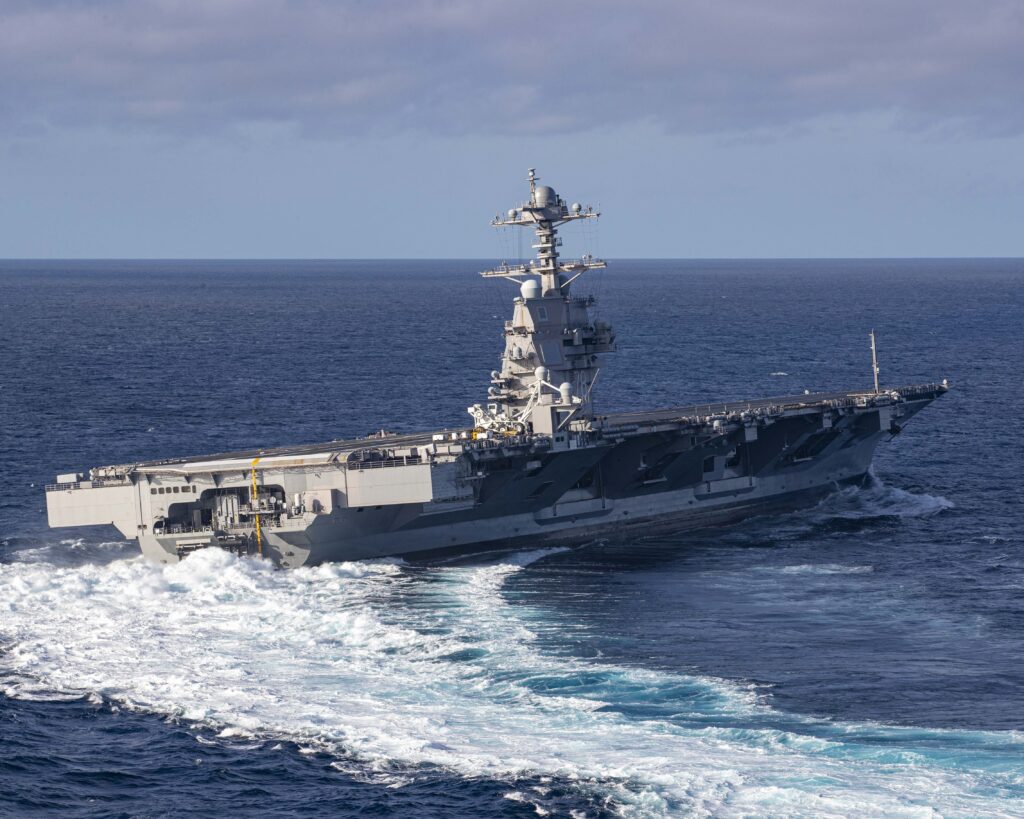
An Arleigh Burke-class destroyer under construction at Bath Iron Works.
The Indicators are unmistakable, and the warnings are clear. Just as in the late 1930s, there is a gathering storm on the horizon and our nation’s security is at risk. Back then, it was Hitler in Germany; Mussolini in Italy; and Tojo in Japan. Now, the growing threat is Putin in Russia and Xi Jinping in China, with Iran and North Korea thrown into the mix.
However, just as in the 1930s when politicians refused to face the monster of totalitarian aggression until it was almost too late, we have seen politicians ignore the gravity of the threat over the last decade and fail to rebuild America’s military strength to a level necessary to deter future war.
President Trump came into office acknowledging the growing threat from China. He was able to generate enough support in Congress to boost defense spending from 3.1% of GDP to 3.5% of GDP before leaving office, but there are clear indications that more will be needed to meet these threats, particularly the threat from China.
Fortunately, President Biden and his top appointees appear to recognize the Chinese threat. Both the new Defense Secretary and the Secretary of State have made clear they see and understand the threat.
Secretary of State Tony Blinken endorsed a tougher approach on China and assured senators he would continue “the commitment to Taiwan.” and that “part of that commitment is making sure that Taiwan have the ability to defend itself against aggression… and that is a commitment that will absolutely endure.”
The Chairman of the Joint Chiefs, Gen. Mark Milley, has also gone on record acknowledging the threat and indicating that there will be a need to shift Pentagon resources from the Army and the Air Force to fund the hundreds of new ships needed to meet the threat from China.
What may be the key to blunting the Chinese threat is a Navy with more and more capable ships.
The Biden Administration will have to decide what to do in the budget-constrained world where huge deficits are the norm and the Covid-19 pandemic has pretty much broken the back of fiscal discipline already. The Democrats may also face political pressure from the left to fund domestic policy preferences and you have the new administration between a rock and a hard place.
A hastily-developed shipbuilding plan rushed out near the end of the Trump Administration set a very modest goal of a 500-ship Navy, but it would achieve that number at a snail’s pace where the fleet would not reach 500 ships until 2045.
We simply can’t wait 25 years. It won’t be enough to deter the Chinese threat. If we are to avoid a future war with China, things are going to have to change and change radically. Even now there are credible analysts who speculate that we could well lose a war with China due to a shortfall in naval capabilities. That is simply an unacceptable outcome!
President Biden and Congress need to understand that we are already deep into a national security crisis. It is here and now. Our nation’s leaders must meet the Constitutional mandate to “Provide for the Common Defense” no matter what the budget consequences.
While that will surely be difficult, Congress has proven that, in dire circumstances, budget priorities can be shifted dramatically. In 1940, after years of providing only modest funding for the Navy, Congress stepped-up and passed the largest naval procurement bill in U.S. history, increasing the size of the Navy by 70%. The threat was real and the need was urgent.
Last year, the Covid-19 coronavirus crisis emerged. The threat was real, and the need was urgent. Within a matter of weeks, the Congress and the President recognized the threat; developed a credible and effective response and committed more than $6 trillion to combat the virus and its economic effects. That’s more than 25% of our nation’s GDP.
If the coronavirus threat presented a national crisis worthy of a $6 trillion response, then surely the growing military threat from China warrants a crisis response. Congress proved in 1940 and again in 2020 that what was considered impossible can be done — if leaders lead.
The good news is that the national security crisis we are facing from China and elsewhere can be met with much more modest incremental expenditures ranging in the tens of billions per year and not the trillions that have been allocated to the COVID-19 threat. Dramatic things can be done. It just takes leadership and will. But the Pentagon and Navy leadership seem all too willing to accept that there can be no budget increases that will allow the kind of rapid naval restoration that is needed to meet the threat.
The budget implications are fairly modest. A $10 billion to $15 billion increase in the Navy’s annual shipbuilding budget would permit a rapid increase in ship construction. More funding would be needed in the out years to boost the R&D, O&M and personnel accounts required to man, operate and maintain the larger fleet.

USS Gerald R. Ford conducts high-speed turns in the Atlantic
In addition to more money, the Navy’s acquisition organization and its mind set must change. Despite talking a good game about learning from the grave mistakes of the past two decades, the Chief of Naval Operations and the Navy leadership appear ready and even comfortable with relying on the same huge, bloated and inefficient acquisition bureaucracy that has rendered such wasteful and significantly flawed ship programs as the Littoral Combat Ship, the Ford-class aircraft carrier and the Zumwalt destroyer.
It is often said that insanity is repeating the same mistakes while expecting different results. Admittedly, the Navy’s acquisition community’s decisions to accelerate submarine construction and launching a derivative new FFG program have helped. But they must do much more. Things like refueling and further extending the life of Nimitz class carriers and making more modifications and upgrades to our existing large surface combatant force of DDGs come to mind. Urgency dictates that the Navy abandon its plan to pursue a decade-long acquisition program for a new large surface combatant and make a major “Block 4” improvement to the proven DDG-51 destroyer instead. That way we can achieve more steel on the water at far less expense and many years sooner.
We know how to build the Arleigh Burke destroyer at a competitive contract price and a fourth block-upgrade to the proven hull design makes sense.
What should be done? Modernize the Aegis combat system; add more VLS cells so that the ship can deploy as a quasi-cruiser; lengthening the ship by roughly 50 feet which would add space for more electrical power generation and possibly add other potential weapons or off-board systems. Knowledgeable naval architects have indicated that this “plug” can be feasibly integrated with the Arleigh Burke design and still maintain a length-to-beam ratio, a bit less than 10-to-1 characteristic of many US Navy DDs and CGs of the past.
We need more ships and more submarines and we need them in this decade — not in 25 years.
With this approach to a larger Navy surface combatant fleet of DDs and quasi-CGs, the serious shortfall in missiles at sea in the western Pacific can be cut significantly. With a rapid introduction of a second source for production of the new Constellation frigate, the construction rate for Large Surface Combatants (LSC) and Small Surface Combatants should reach a comfortable eight to 10 hulls each year.
The Biden Administration and Congress must recognize that we are in very dangerous times and choose to do things differently and get more steel on the water as fast as possible. That is what was done in 1940 and it is what is needed now.
Christopher Lehman served as legislative assistant for defense to Sen. John Warner 1979-1981 and as special assistant for national security affairs to President Reagan from 1983-1985.
Why supporting Ukraine is ‘main priority’ for Norway’s defense chief this year
“I have more sense of urgency in 2024 than I had in 2023” about how quickly Russia can rearm its military, Norway’s Chief of Defense, Gen. Eirik Kristoffersen, told Breaking Defense.


























